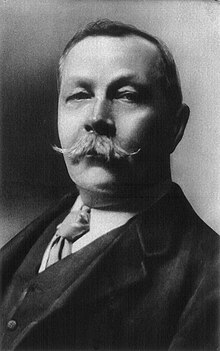About the Book: "The Adventure of the Speckled Band" is one of the 56 short Sherlock Holmes stories written by Scottish author Sir Arthur Conan Doyle. It is the eighth of the twelve stories collected in The Adventures of Sherlock Holmes. It is one of four Sherlock Holmes stories that can be classified as a locked room mystery. The story was first published in Strand Magazine in February 1892, with illustrations by Sidney Paget. It was published under the different title "The Spotted Band" in New York World in August 1905. Doyle later revealed that he thought this was his best Holmes story.
About the Author: Arthur Ignatius Conan Doyle was born on 22 May 1859 at 11 Picardy Place, Edinburgh, Scotland. From 1876 to 1881, he studied medicine at the University of Edinburgh, including a period working in the town of Aston (now a district of Birmingham) and in Sheffield, as well as in Shropshire at Ruyton-XI-Towns. While studying, Doyle began writing short stories. His earliest extant fiction, "The Haunted Grange of Goresthorpe", was unsuccessfully submitted to Blackwood's Magazine. His first published piece "The Mystery of Sasassa Valley", a story set in South Africa, was printed in Chambers's Edinburgh Journal on 6 September 1879. On 20 September 1879, he published his first non-fiction article, "Gelsemium as a Poison" in the British Medical Journal. In 1882 he joined former classmate George Turnavine Budd as his partner at a medical practice in Plymouth, but their relationship proved difficult, and Doyle soon left to set up an independent practice. Arriving in Portsmouth in June of that year with less than £10 (£900 today) to his name, he set up a medical practice at 1 Bush Villas in Elm Grove, Southsea. The practice was initially not very successful. While waiting for patients, Doyle again began writing stories and composed his first novels, The Mystery of Cloomber, not published until 1888, and the unfinished Narrative of John Smith, which would go unpublished until 2011. He amassed a portfolio of short stories including "The Captain of the Pole-Star" and "J. Habakuk Jephson's Statement", both inspired by Doyle's time at sea, the latter of which popularized the mystery of the Mary Celeste and added fictional details such as the perfect condition of the ship (which had actually taken on water by the time it was discovered) and its boats remaining on board (the one boat was in fact missing) that have come to dominate popular accounts of the incident. Doyle struggled to find a publisher for his work. His first significant piece, A Study in Scarlet, was taken by Ward Lock Co. on 20 November 1886, giving Doyle £25 for all rights to the story. The piece appeared later that year in the Beeton's Christmas Annual and received good reviews in The Scotsman and the Glasgow Herald. The story featured the first appearance of Watson and Sherlock Holmes, partially modeled after his former university teacher Joseph Bell. Doyle wrote to him, "It is most certainly to you that I owe Sherlock Holmes ... Round the center of deduction and inference and observation which I have heard you inculcate I have tried to build up a man." Robert Louis Stevenson was able, even in faraway Samoa, to recognize the strong similarity between Joseph Bell and Sherlock Holmes: "My compliments on your very ingenious and very interesting adventures of Sherlock Holmes. ... Can this be my old friend Joe Bell?" Other authors sometimes suggest additional influences—for instance, the famous Edgar Allan Poe character C. Auguste Dupin. A sequel to A Study in Scarlet was commissioned and The Sign of the Four appeared in Lippincott's Magazine in February 1890, under agreement with the Ward Lock company. Doyle felt grievously exploited by Ward Lock as an author new to the publishing world and he left them. Short stories featuring Sherlock Holmes were published in the Strand Magazine. Doyle first began to write for the 'Strand' from his home at 2 Upper Wimpole Street, now marked by a memorial plaque. In this period, however, Holmes was not his sole subject and in 1893, he collaborated with J.M. Barrie on the libretto of Jane Annie. Doyle was found clutching his chest in the hall of Windlesham Manor, his house in Crowborough, East Sussex, on 7 July 1930. He died of a heart attack at the age of 71. His last words were directed toward his wife: "You are wonderful." At the time of his death, there was some controversy concerning his burial place, as he was avowedly not a Christian, considering himself a Spiritualist. He was first buried on 11 July 1930 in Windlesham rose garden. He was later reinterred together with his wife in Minstead churchyard in the New Forest, Hampshire. Carved wooden tablets to his memory and to the memory of his wife are held privately and are inaccessible to the public. That inscription reads, "Blade straight / Steel true / Arthur Conan Doyle / Born May 22nd 1859 / Passed On 7th July 1930." The epitaph on his gravestone in the churchyard reads, in part: "Steel true/Blade straight/Arthur Conan Doyle/Knight/Patriot, Physician, and man of letters". Undershaw, the home near Hindhead, Haslemere, south of London, that Doyle had built and lived in between October 1897 and September 1907, was a hotel and restaurant from 1924 until 2004. It was then bought by a developer and stood empty while conservationists and Doyle fans fought to preserve it. In 2012 the High Court ruled that the redevelopment permission be quashed because proper procedure had not been followed. A statue honours Doyle at Crowborough Cross in Crowborough, where he lived for 23 years. There is also a statue of Sherlock Holmes in Picardy Place, Edinburgh, close to the house where Doyle was born.
My Review: Another magnificent story with a very elaborated plot: Holmes' client is Helen Stoner, a 32 year old spinster who lives with her stepfather: Dr. Grimesby Roylott of Stoke Moran. Dr Roylott is the last survivor of what was a wealthy but dissolute and violent tempered aristocratic Anglo-Saxon family of Surrey. After returning from India where he had a large medical practice and had served a jail sentence for killing his native Butler in a fit of rage, Roylott—a widower—settles with his two stepdaughters in the broken-down ancestral manor-all that is left of estates that had extended into Berkshire and Hampshire. The doctor becomes notorious for terrorizing the local village because of his quarrelsome personality and violent temper. Dr. Roylott has required Miss Stoner, who is engaged to be married, to move into a particular bedroom of his heavily mortgaged ancestral home in Stoke Moran. This room was the one in which two years before, Helen's twin sister Julia had died under mysterious and dramatic circumstances—uttering the last words "The band! The speckled band!"—just prior to her wedding. Helen is reluctant to sleep in the room because a number of things about the bedroom are mysterious and disturbing. Late at night, Helen hears low whistling sounds followed by a metallic clang. There is a strange bell cord over the bed but it does not appear to work any bell. The rope goes to a ventilator—an opening high in the wall of the room, close to the ceiling—which provides air circulation between Helen's room and an adjacent room of Dr Roylott in the crumbling mansion. In addition, Helen's bed is clamped to the floor; this piece of furniture can never be moved from its position. Stoner surmises that Julia might have been murdered by the gypsies who wear speckled handkerchiefs around their necks, in order to bring in a bit of cash. Dr. Roylott has rented spare rooms in Stoke Moran near them. A cheetah and a baboon also have the run of the property, for Dr. Roylott keeps exotic pets from India.
After Helen leaves, Dr. Roylott comes to visit Holmes, having traced his stepdaughter. He demands to know what Helen has said to Holmes, but Holmes refuses to say. Dr. Roylott bends an iron fireplace poker into a curve in an attempt to intimidate Holmes, but Holmes is unaffected as he attempts to make small talk during the encounter. After Roylott leaves, Holmes straightens the poker out again. Holmes research of the late wife's will finds that she had arranged for Roylott to receive an annuity which had been £ 1,100 GBP but now totals £ 750 GBP, with the provision that the daughters can each claim 1/3 of the annuity (£ 250 GBP) upon marriage. If both or even one daughter were to marry and claim the annuity due her, this would seriously pauperize Roylott financially-thus the doctor has motive for neither daughter to marry.
Having arranged for Helen to spend the night in another bedroom, Holmes and Watson sneak into her bedroom without Dr. Roylott's knowledge. Holmes says that he has already deduced the solution to the mystery, and the test of his theory turns out to be successful. They hear the whistle, and Holmes also sees what the bell cord is really for, although Watson does not. Julia's last words about a "speckled band" were in fact describing "a swamp adder, the deadliest snake in India". The adjacent room was occupied by Dr. Roylott and a safe containing the venomous snake, and the ventilator and bell cord were bridges for the snake to land on the bed. After the swamp adder bit Julia, he called off the snake with the whistling, which made the snake climb up through the bell cord, disappearing from the scene.
Now the swamp adder is sent again through the ventilator by Dr. Roylott to kill Julia's sister Helen. Holmes attacks the snake with a walking stick, sending it through the hole in the wall back toward its home in the physician's room. A shriek is heard, and the annoyed reptile is soon found to have injected its venom into the murderous physician. When Holmes and Watson enter the death scene, the swamp adder has wound its body around the head of its victim in triumph. Holmes replaces the reptile into the safe. A coroner's jury finds that Dr. Roylott came to his death due to indiscreet handling of a dangerous pet. Holmes grimly notes that he is indirectly responsible for Dr. Roylott's death, but that he is unlikely to feel much guilt over the chain of events that led to his departure from this world.
I recommend this book to any reader that is a lover of a good mystery and a Sherlock Holmes story.
If you read this review, feel free to leave a comment!



No comments:
Post a Comment